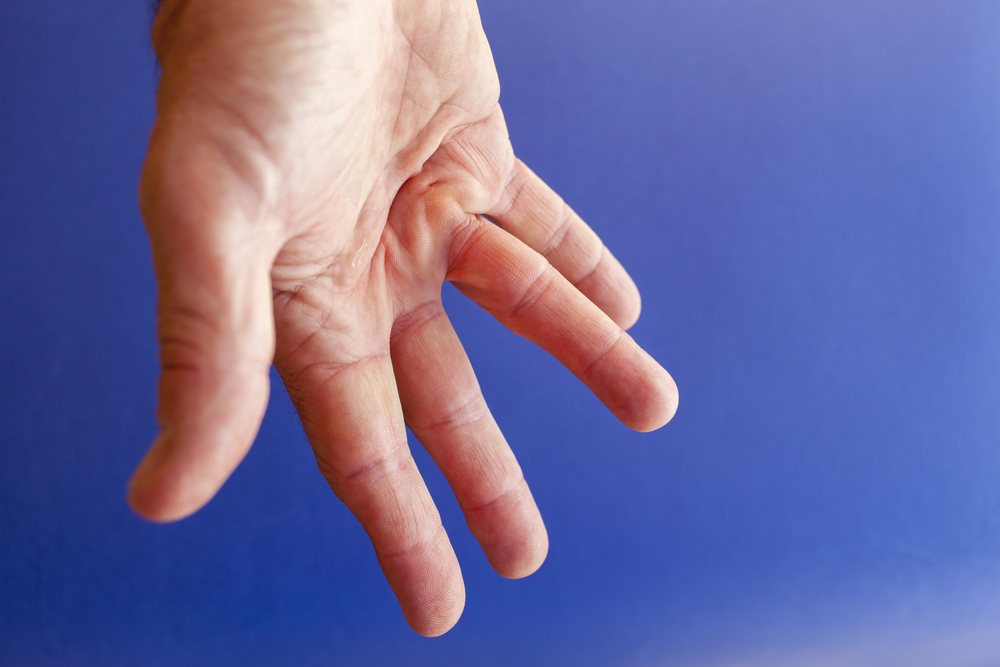Dupuytren contractures is a condition that affects the hands. It causes one or more fingers to contract toward the palm due to the fascia or a layer of tissue under the skin to become abnormally thickened. This abnormal thickening occurs in the palm of the hand at the base of the fingers. The tissue will either be a lump or a thick band. The fingers that are affected will not be able to straighten completely.
Causes
The cause of Dupuytren is unknown, though it tends to run in families. It has also been shown to be linked to smoking, alcoholism, diabetes, nutritional deficiencies, and medication that is used to treat seizures. Being middle aged, a man, having a family history, having diabetes, smoking, or taking seizure medication raises your risk of developing Dupuytren contractures.
Symptoms
This condition is slow in progression. Symptoms worsen over time. The first symptom you may discover is a firm lump in the palm of your hand. Over time the lump will turn into long thick cords that move up from the palm to your fingers. After the cords appear the contractures of your fingers will occur. This condition is usually not painful. The little finger, and ring finger are the most commonly affected. This condition can affect both hands.
Diagnosis
Usually Dupuytren contracture can be diagnosed with just a physical examination. Your doctor will be able to look at both your hands to compare them. They may also have you do the flat surface test, which is where you lay your palm down against a hard flat surface and try to straighten your fingers out completely.
Knowing your family history, if you have someone else in your family with this condition will also help your doctor be able to diagnose. This condition progresses very slowly so it may be later in your life before you have any major side effects or symptoms.
Treatment
There is no cure for this condition but there are a number of treatment options.
Treatment for Dupuytren is to break apart the fascia or the layer of tissue below the skin, that is pulling on the fingers. There are a few different options you can choose from to achieve this. In the early stages of the disease you can have steroid injections done. The injection will be done in the lump of the palm of the hand. This will help soften and flatten the lump. Though eventually the condition will progress to a point where these injections will no longer be effective.
Another injection option is an injection of a specific enzyme, collagenase. This enzyme when injected will help soften and weaken the lumps, then a week after the injection the doctor will manipulate your fingers in a way to help break apart the thickened fascia in the hand. This treatment can help reduce and eliminate contractures for years.
Another treatment option is needling. This is when a needle is inserted into the hand after being numbed. The needle is then used to cut away and break apart the thickened fascia. Needling can be done in the office, and there isn’t much recovery time. Multiple fingers can be done at once with needling. Needling cannot be done in certain areas of the fingers and palm because it could cause nerve damage. With needling the contractures will recur, but the procedure can be repeated.
Surgery is a treatment option for when symptoms have become severe. There are two different surgery procedures that can be done. One a fasciotomy which is when a surgeon will go in surgically through the palm and break apart the fascia. The cords of tissue are not removed, but breaking them up will help stop contractures and allow movement in the affected finger. This surgery is less invasive, the wound is left open to heal on its own, and you will have to wear a splint during the healing process. The surgery is done with local anesthesia where only your hand will be numb and you aren’t put under.
The other surgical option is a subtotal palmar fasciotomy. This is when a surgeon will make an incision in your hand and remove as much of the abnormal tissue as possible. This is a more invasive surgery and the recovery can be long. Sometimes the wound will be left open to heal, in other cases you will need a skin graft to cover over the opening. This treatment option is more complete and longer lasting. It does have a long recovery, longer wound healing, physical therapy, as well as the responsibility of the patient to do their part in recovery. With any surgery there are risks, but some can be pain, numbness, wound infection, and stiffness. This is not a cure for the condition, but a treatment option. Most patients will see no contracture recurrence. About 20% though will see some degree of contracture recurrence after the surgery has been completed.
Takeaway
There is no cure for Dupuytren contracture. There are treatment options to help lessen the severity of the contractures. This is a slow progressing disease that worsens over the years. Some people may not see any symptoms until they are past middle aged. Dupuytren contracture tends to run in families. With early diagnosing, early treatment can start to help lessen symptoms as the condition progresses.
Dupuytren contracture is linked to family history, alcoholism and diabetes. Know your risk and the signs. #HealthSurgeon
Stop aging in it’s tracks with Purium’s Revive It All! Revive It All contains two very important ingredients that have been proven to help reverse memory loss and increase energy and vigor: Acetyl L-Carnitine and Alpha Lipoic Acid.
Sources:
https://www.hopkinsmedicine.org/health/conditions-and-diseases/dupuytrens-contracture#:~:text=Dupuytren’s%20contracture%20is%20an%20abnormal,your%20hand%20for%20certain%20things.
https://www.mayoclinic.org/diseases-conditions/dupuytrens-contracture/diagnosis-treatment/drc-20371949
https://orthoinfo.aaos.org/en/diseases–conditions/dupuytrens-disease/

